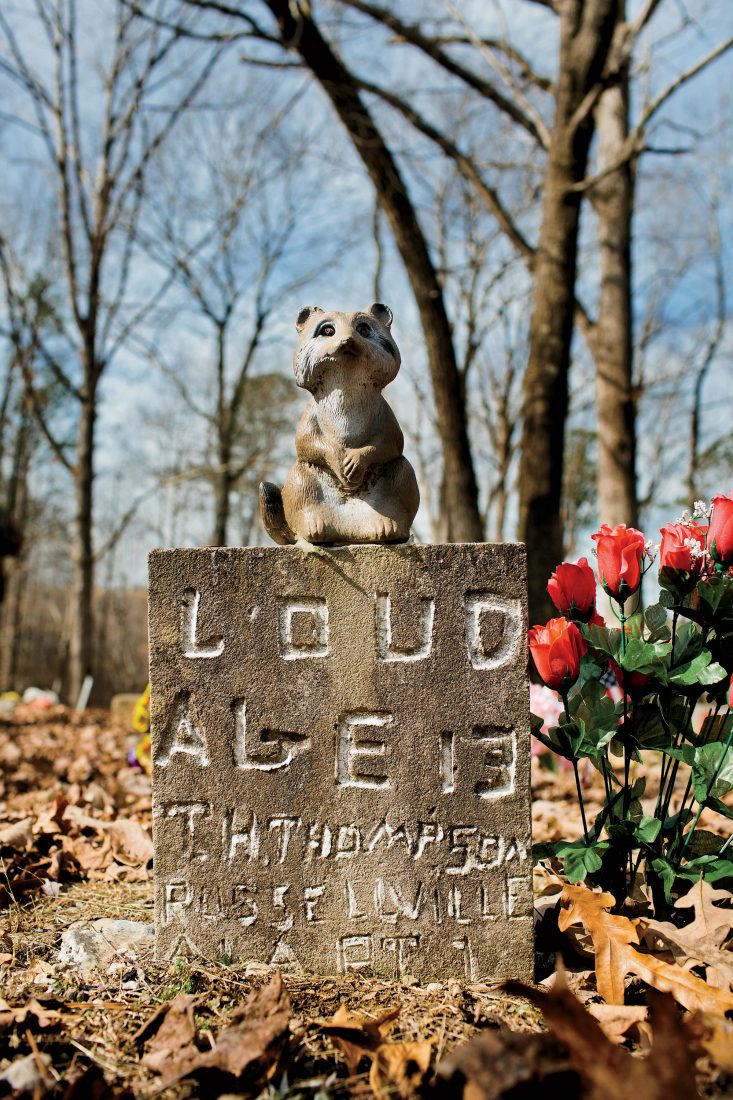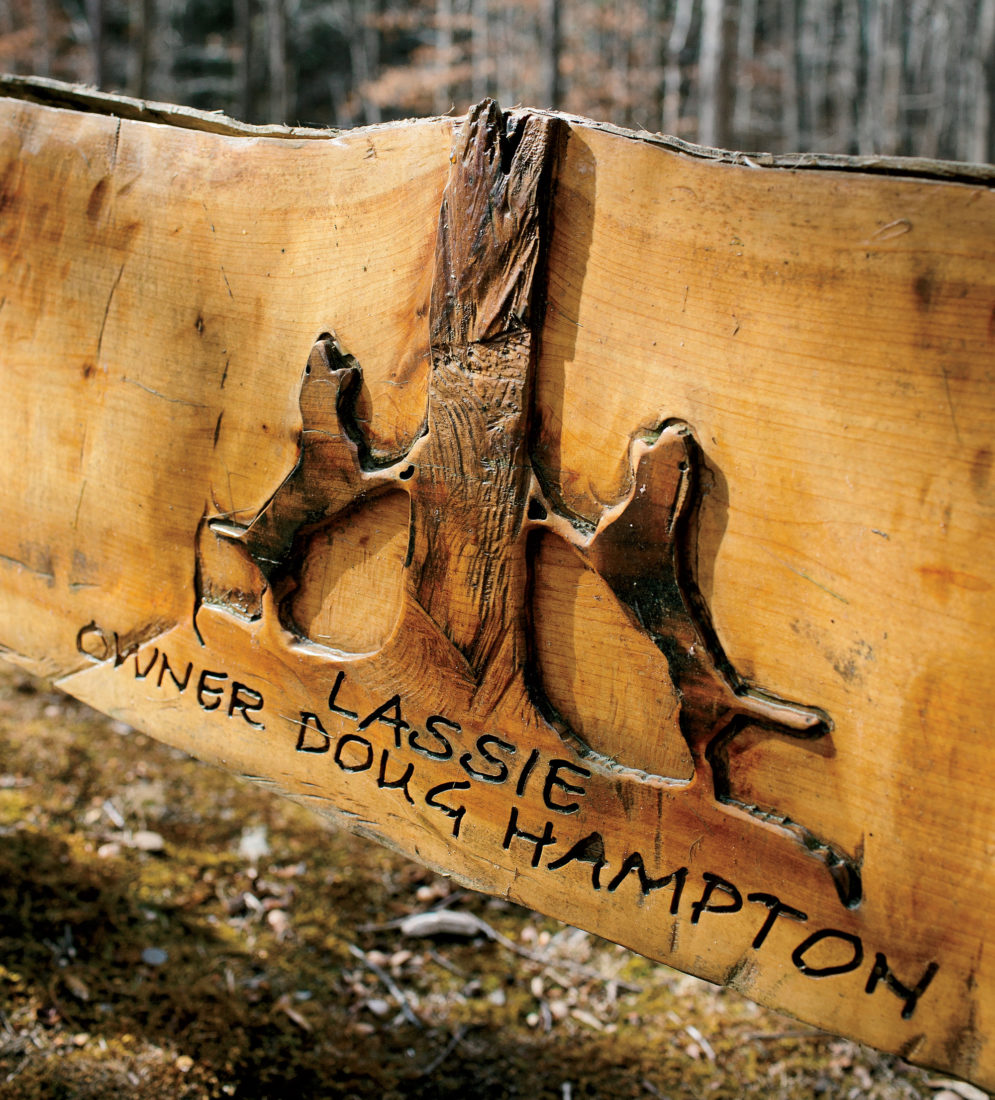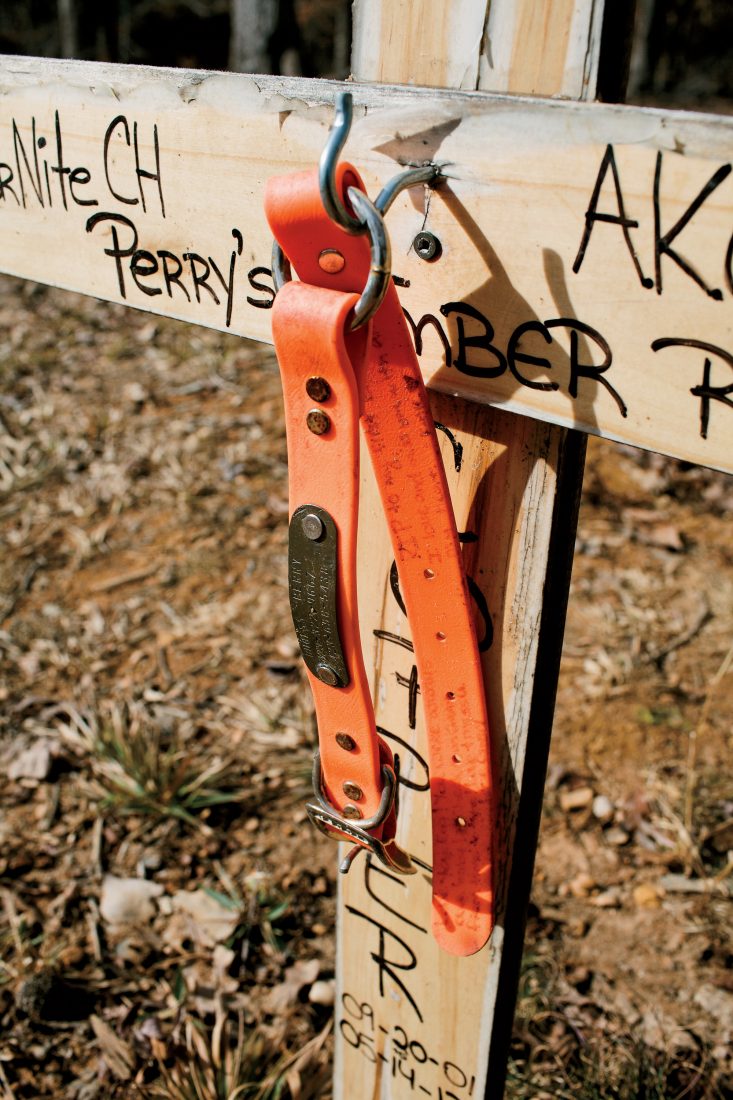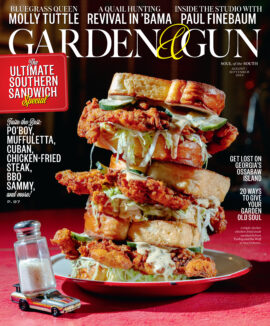Good Dogs
Alabama’s Coon Dog Cemetery
Deep in the Alabama woods at the base of the Cumberland Mountains lies a cemetery like no other

Photo: Caleb Chancey
Seventy-seven years ago this place was just a gently sloping rise in the Freedom Hills, prolific with hardwoods—elm, oak, ash—and pine trees too, but with enough open space left over to walk between them, even with a dog. The rise fell like a slide into a holler, thickly wooded and dark, though at certain times of the day when the sun cut through the treetops there was a winking glint off a moonshiner’s still. Beyond that nothing but green, an ocean of forest, and all the critters you’d expect to find there: barred owls, kestrels, fox squirrels, deer. Raccoons.
Seventy-seven years ago, in 1937, Key Underwood buried his dog, a coonhound, here, because this is a place they loved to hunt. The dog’s name was Troop, and he carved that name into a chunk of sandstone from the chimney of an old cabin with a screwdriver and a hammer, and below that the essential information, the only indisputable facts of existence: the day he was born and the day he died.
4-1-22
9-4-37
This is what was happening in September 1937 on a mountaintop in Cherokee, Alabama.

Photo: Caleb Chancey
The Last Howl
A hand-carved marker.
Since then, more than three hundred dogs have been buried here. And not just any dogs: They are, each and every one of them, coonhounds. Redbone, black and tan, English bluetick, English redtick, Plott, Treeing Walker, and various combinations of the above. It’s a place that’s known as—well, what else could it be known as?—the Coon Dog Cemetery (officially the Key Underwood Coon Dog Memorial Cemetery), and there is no place like it anywhere in the world.
Cherokee is a townlet in northern Alabama, Huddled at the bottom of the Cumberland Mountain Range. It’s near Tuscumbia, where Helen Keller was born, and not far from Muscle Shoals, where modern rock and roll was born, and it’s just a stone’s throw away from Wilson Dam, where people say your eighty-pound catfish are born. But Cherokee, population hovering around twelve hundred souls, is known more for the end of things than the beginning.
The Coon Dog Cemetery has its own road—Coon Dog Cemetery Road—a ten-mile-long stretch of winding rolling beauty, a barely paved one-and-a-half-lane road with steep hills and sharp curves sketched through a thousand acres of nothing much. You’re never going to get there without going there, because it’s not on the way to anywhere else. That said, the space here feels more sequestered than it does isolated. I won’t call it holy because that’s a big word that brings a lot of baggage. But hallowed? Sure. It’s a hallowed spot. A place like this shouldn’t be too close to anything else. It’s one of those places you wish you couldn’t find with a GPS.
Janice M. Williams, aka the Coon Dog Lady, the cemetery’s caretaker and also president of its board, took me up the mountain in her Alabama crimson red Ford F150, a trip she could make with her eyes closed and blindfolded and in her sleep, she’s done it so often. All the way there we listened to a compilation of coon-dog-related tunes on her CD player. I liked some of the songs better than others, but one thing is clear: It’s impossible to sing a song about coon dogs without having a lot of people barking and baying in the background pretending to be coon dogs. Williams is the perfect guide. Besides being a great storyteller and funny as all get-out, she knows everything. I’m not kidding. She used to work at the tourism bureau, so if you have a question about Tuscumbia or Cherokee, go no further. (She even told me a couple of things about Helen Keller I didn’t know, one of them semi-scandalous.)

Photo: Caleb Chancey
Janice M. Williams on the cemetery grounds.
But she is especially knowledgeable about the Coon Dog Cemetery, of course, a walking, talking repository of it all. She was the first person she knows of to actually count the graves scattered across that pastoral acre: 307 as of January 2014. She keeps it presentable (without care the forest quickly encroaches) and makes sure there are flowers on every grave—plastic flowers, alas, but flowers nonetheless, and also a scattering of American flags. The cemetery has been her “baby” since 2009; for fifty or so years before that it had been in the hands of O’Neal Bolton, and he was amazing at it. But it was time for someone new to step in, and thus he bestowed upon her the right and the duty to keep it going. Nothing was signed, of course, no persnickety contract; it was all done on a promise and a handshake, a promise she has fulfilled and then some, because this is no mere job for Williams. “I love this place,” she says, “love it even though I’ve never hunted, love it even though I’ve never even had a coon dog. There’s something about it. You’ll feel it when we get there.”
We drive up a hill as steep as a roller coaster’s climb, the road flattens out for a bit, and there’s the painted metal sign indicating our destination—Coon Dog Cemetery—on the left. “I come up here sometimes by myself,” Williams says. “I don’t tell anybody. I just like to be here, alone. It’s so peaceful.” She puts the truck in park and slips her arms through her jacket sleeves. “Of course, I bring a gun.” She shrugs. “You never know.”

Photo: Caleb Chancey
New Beginnings
Franky Hatton with his bluetick, Phydoe, and his cousin's three-month-old redbone at the graves of his pervious coon dogs.
In some respects, the Coon Dog Cemetery looks a lot like other cemeteries in which there are not coon dogs. Traditional rectangular sandstone gravestones are inscribed with names, dates, and sometimes a pithy remembrance: “He wasn’t the best, but he was the best I ever had,” or simply “In Loving Memory.” But there is more than one way to mark a grave, and in the Coon Dog Cemetery you might could see them all. Some are just pieces of wood or rocks, or combinations of both; one looks like the other side of a car tag, one a small piece of a wrought-iron fence, and one—“Bear”—a rusting piece of soldered metal on a pole: This one is Williams’s favorite. Pennies have been placed on many of the markers, an acknowledgement from visitors who were particularly touched by a grave. The sun breaks through the treeless limbs of a pin oak, like God’s spotlight, illuminating it all. Having been a longtime lover of both dogs and cemeteries, I am in heaven.
Franky Hatton is there to meet us. He is a hunter who has two coon dogs buried here: Blueflash, and the son of Blueflash, Blueflash Jr. He brought one of his living dogs along with him, a bluetick named Phydoe, and his human son too, sixteen-year-old Heath. Most serious coon dog hunters have their dogs registered with the American Kennel Club, and through that organization their lineage can be traced back several generations, just like the kings and queens of England. But the hunters have a lineage too: Franky’s father was a hunter, the same as his father’s father was, and Franky’s son is a hunter. The dogs and the men are coupled through time, past, present, and future, inextricably and devotedly; they’re like a hybrid, half dog, half man, a mythical creature, so hard is it to imagine one without the other.
Blueflash and Blueflash Jr. are buried next to each other, the graves marked with stone slabs crowded with information. Both of them were AKC and UKC (United Kennel Club) Grand National Champions, but there was something special about Blueflash Jr. “The only time my family has seen me cry is the day we buried him,” Franky says. “I traveled a lot of miles with that dog. Junior was just the best. His father was good too, but he would take his time, he was sort of laid-back. But as soon as Junior got the scent he took off. He could tree a raccoon in a heartbeat.”
Franky and his cousin Lee Hatton, whose family joins us after a bit, have been hunting since they were big enough to follow their fathers around in the woods. Franky is in his mid-forties and Lee is a little younger, but both can remember when they used to hunt on horseback, following the sound of their dogs’ voices over rivers and through the trees. Things have gotten easier for the humans since then: Dogs’ collars can now be equipped with a transmitter so their owners can follow with a GPS device.

Photo: Caleb Chancey
A coon dog’s collar hangs in memory.
But the most important technology, the man and the dog, hasn’t changed in quite a while. Dogs aren’t only man’s best friend; sometimes they’re his only friend, because there is not enough time in a day to raise, train, and hunt with your dog. Franky Hatton had a wife once. She felt like the long nights tracking had gotten out of hand. Finally she told him, “It’s either me or the dogs.”
Franky is now engaged to a lovely woman and seems quite content. Lee’s wife, Courtney, has insulated herself a bit from hound-related marital demise by getting involved in the avocation herself: She helped train one of their dogs in a baby pen in their living room with a stuffed animal raccoon imbued with the scent of the real thing. His name was Beethoven and he turned out to be the best tracker Lee had ever seen. But he’s dead now too, drowned in a river. Very grim. And heartbreaking. Lee couldn’t even finish that story, it hurt so much to tell it.
The address 4945 Coon Dog Cemetery Road is an exclusive one. Its exclusivity is enforced in part by Williams, through whom one has to go for permission to have one’s dog buried there. But it’s tradition that backs her up, and tradition, as usual, is pretty straightforward: Coon dogs were developed for their keen sense of smell, to track and chase any animal they’re trained to, and to follow it on the ground and even when it takes to the trees. So if your dog hasn’t treed a raccoon, it isn’t a coon dog. Even if your dog is AKC registered with a bloodline going back to the time of George Washington, if you can’t present a letter testifying to the fact that someone in addition to you saw your dog tree a raccoon, you might need to find another place to bury your best friend. And that’s if your dog is registered. If not, you need three witnesses. There is no gate to the cemetery, no guard; but if someone were to bury a dog there without first obtaining permission, there would be an emergency exhumation.
It has happened.
Sadly, perhaps, there’s not a Chihuahua graveyard, not anywhere in the world.
Troop, Bear, Famous Amos, Blaze, Lulubelle, Preacher, Loud, Duke, Beanblossom Bud, Merch, Crackerjack, Flop, Black Ranger, Quinn’s Pearl, Bragg, Train—the beautiful names of the dogs buried here. I had a coonhound when I was a boy, a black and tan I named Mosby. I was sixteen and I was working for a vet that summer, and when the veterinarian’s bitch had a brood, I bought one from him for a hundred dollars, which he took in increments out of my paycheck. Mosby was my first dog. He slept with me, rode with me. I was never without him until school started up again. I took him to obedience school and he did really well, but the day he was supposed to graduate he died—was run over by a car. I buried him in my backyard and marked the grave with stones. Five years later I came home from college and tried to dig him up. I wanted to see what he looked like now, but I couldn’t find him. And I dug for a long time.
You’ll feel it when we get there, Williams said. And you do. But what is the it? It’s different than the it you feel in a person cemetery. The truth is, our cemeteries are melancholy places. There’s so much sadness when we think of the lives that ended in loneliness, or anger, sick or in pain. But here in the Key Underwood Coon Dog Memorial Cemetery, every one of these dogs spent twelve years more or less with a man or a woman who loved them, and whom they loved, every single day. Twelve years is a long time to be loved like that, and it’s a good life for a dog. It’s a good life for anybody. This is the only graveyard I’ve been to that was less an acknowledgment of death than it is a celebration of what almost certainly was, grave for coon dog grave, a damn good life. Every Labor Day—in memory of Troop, who was buried on Labor Day weekend such a long time ago—they have a big celebration here, with bands and storytellers and food. Next Labor Day I want to be there. I can’t think of a better place to have a party.







